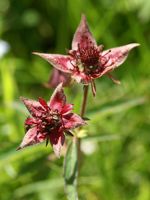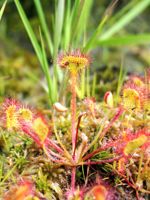Mon-Fri 9am - 5pm Mountain time
Marsh Cinquefoil vs Round-Leaved Sundew
Comarum palustre
Drosera rotundifolia
CUSTOM GROW
CUSTOM GROW
Marsh Cinquefoil is a native perennial wetland plant with striking reddish-purple, star-shaped flowers. They bloom in early to mid-summer, providing nectar for bees, flies, and other pollinators. Beyond its summer blooms, the foliage turns red in autumn, adding seasonal interest to wetland landscapes.
Common in wetlands, pond margins, and wet meadows, Marsh Cinquefoil spreads by rhizomes to form colonies or patches that contribute to shoreline stabilization. It thrives in nutrient-poor, saturated soils where many other plants struggle, making it valuable in challenging wetland conditions. With its ecological function and ornamental appeal, it is well-suited for wetland plantings, ecological restoration, and naturalized projects.
Round-Leaved Sundew is a native carnivorous plant, easily recognized by its bright green leaves covered in distinctive red, glandular hairs. These hairs secrete a sticky substance that is used to attract, trap, and digest insects. Their carnivorous nature allows them to survive in nutrient-poor, acidic soils where many other plants may struggle to grow.
They produce small white flowers that grow along the top of a slender, leafless stem. They can be found growing in wetlands, most often among sphagnum moss, in consistently moist, acidic soils. It does best in cooler summer climates and is intolerant of shade. Due to its small size, the plant can be difficult to spot in its natural habitat. Round-Leaved Sundew is an indicator of healthy wetland systems and is valued in ecological restoration and conservation projects.

